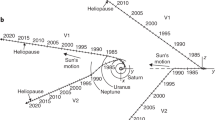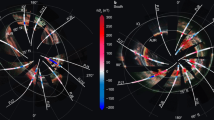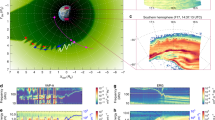Abstract
The galilean moons of Jupiter are substantial bodies—three of them are larger than the Earth's Moon, and one is larger than Mercury—yet little has been known about them until very recently. The discovery of a magnetosphere1 and magnetic field2 associated with Ganymede was surprising, and raised the possibility that other galilean satellites, particularly Callisto (which is the second largest after Ganymede), also might have an internally generated magnetic field. Here we report observations of plasma waves around Callisto, detected during the recent fly-by of the Galileo spacecraft. The nature of the plasma waves indicates that Callisto, unlike Ganymede, does not have a magnetosphere or an internal magnetic field. The electron density near Callisto, however, is substantially higher than that in Jupiter's magnetosphere at this orbital radius, indicating that Callisto is a significant source of locally generated plasma. This plasma most probably comes from a tenuous atmosphere around Callisto, which may be similar to the hydrogen cloud around Ganymede, as the electron densities are somewhat comparable.
This is a preview of subscription content, access via your institution
Access options
Subscribe to this journal
Receive 51 print issues and online access
$199.00 per year
only $3.90 per issue
Buy this article
- Purchase on Springer Link
- Instant access to full article PDF
Prices may be subject to local taxes which are calculated during checkout
Similar content being viewed by others
References
Gurnett, D. A., Kurth, W. S., Roux, A., Bolton, S. J. & Kennel, C. F. Evidence for a magnetosphere at Ganymede from plasma-wave observations by the Galileo spacecraft. Nature 384, 535–537 (1996).
Kivelson, M. G. et al. Discovery of Ganymede's magnetic field by the Galileo spacecraft. Nature 384, 537–541 (1996).
Johnson, T. V., Yeates, C. M. & Young, R. The Galileo mission overview. Space Sci. Rev. 60, 3–21 (1992).
McNutt, R. L., Belcher, J. W. Jr & Bridge, H. S. Positive ion observations in the middle magnetosphere of Jupiter. J. Geophys. Res. 86, 8319–8342 (1981).
Gurnett, D. A. et al. The Galileo plasma wave investigation. Space Sci. Rev. 60, 341–355 (1992).
Stix, T. H. The Theory of Plasma Waves 12 (McGraw-Hill, New York, 1962).
Khurana, K. K., Kivelson, M. G., Russell, C. T., Walker, R. J. & Southwood, D. J. Absence of an internal magnetic field at Callisto. Nature 387, 262–264 (1997).
Walsh, D., Haddock, T. F. & Schulte, H. F. Cosmic radio intensities at 1.225 and 2.0 MC measured up to an altitude of 1700 km. Space Res. 4, 935–959 (1964).
Mosier, S. R., Kaiser, M. L. & Brown, L. W. Observations of noise bands associated with the upper hybrid resonance by the IMP 6 radio astronomy experiment. J. Geophys. Res. 78, 1673–1677 (1973).
Warwick, J. W. et al. Voyager 1 planetary radio astronomy observations near Jupiter. Science 204, 995–998 (1979).
Gurnett, D. A., Scarf, F. L., Kurth, W. S., Shaw, R. R. & Poynter, R. L. Determination of Jupiter's electron density profile from plasma wave observations. J. Geophys. Res. 86, 8199–8212 (1981).
Kurth, W. S., Barbosa, D. D., Gurnett, D. A. & Scarf, F. L. Electrostatic waves in the Jovian magnetosphere. Geophys. Res. Lett. 7, 57–60 (1980).
Barth, C. et al. Galileo Ultraviolet Spectrometer observations of atomic hydrogen in the atmosphere of Ganymede (abstr.). Eos 77, F430 (1996).
Kellogg, P. J. et al. Observations of plasma waves during a traversal of the Moon's wake. J. Geophys. Res. 23, 1267–1270 (1996).
Scarf, F. L. et al. Plasma wave observations at comet Giacobini-Zinner. Science 232, 377–381 (1986).
Anderson, J. D., Lau, E. L., Sjogren, W. L., Schubert, G. & Moore, W. B. Gravitational evidence for an undifferentiated Callisto. Nature 387, 264–266 (1997).
Author information
Authors and Affiliations
Rights and permissions
About this article
Cite this article
Gurnett, D., Kurth, W., Roux, A. et al. Absence of a magnetic-field signature in plasma-wave observations at Callisto. Nature 387, 261–262 (1997). https://doi.org/10.1038/387261a0
Received:
Accepted:
Issue Date:
DOI: https://doi.org/10.1038/387261a0
This article is cited by
-
Absence of an internal magnetic field at Callisto
Nature (1997)
Comments
By submitting a comment you agree to abide by our Terms and Community Guidelines. If you find something abusive or that does not comply with our terms or guidelines please flag it as inappropriate.



